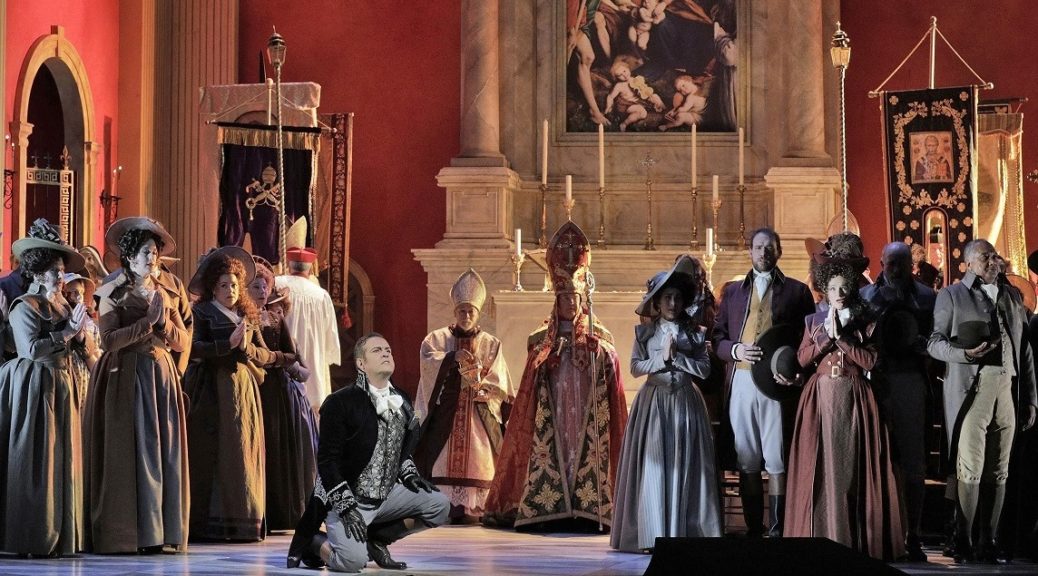
SEXUAL HARASSMENT IN A VINTAGE ITALIAN OPERA
I’ve heard various “shabby little shockers” in opera, but “Tosca” is not one of them. The late (and revered) Berkeley musicologist Joseph Kerman called it that 66 years ago, dismissing one of the most hot-blooded dramas of the early 20th century, powered by a very current theme of sexual harassment. And, as usually happens, the woman is a victim. Yes, Prof. Kerman, that theme is always a shocker, but far more “elegant, monumental” than shabby in this reprise.
“Tosca” is unique, the one quasi-Verdian score in all of Puccini’s oeuvre, full of passion, intrigue, deceit, villainy, revolutionaries, hypocrites, pretenders and, above all, a vulnerable diva—Tosca herself. The convoluted detective plot, coming from a Sardou play, pits Tosca against the conniving and rapacious villain Baron Scarpia, with her beloved Mario as Scarpia’s pawn. In the dramatically astute confrontation scene, Scarpia betrays her to bed her down. She, in the stabbing scene, betrays him in return.
For the true music-lover bored with detective stories, Puccini provides leitmotifs tied to people and actions. Bits of the Scarpia theme already appear on the very first page of the score focused more on the breezy church-mural scene about to dawn.
This lavish reprise of beloved “Tosca,” already played at the S.F. Opera over an amazing 38 seasons, is attractive, most notable for the mobile stage direction of Shawna Lucey and the conducting of Englishman Leo Hussain. Hussain added some dramatically effective pauses into his beat while making his SFO debut.
Essaying her very first Tosca, soprano Carmen Giannattasio had a tough row to hoe, stepping onto the same stage as formidable predecessors Leontyne Price and Gwyneth Jones. Vocally she was secure in solos and duets, with appealing, unforced sound, best in the show-stopping soliloquy “Vissi d’arte.” But dramatically she was far more convincing in the lyrical sweet-gal persona than as the tempestuous diva with an iron resolve. The staunch diva side must emerge in the tense confrontation scene—the high point of the opera—where Tosca and Scarpia are “rolling dice” for the life of the captive, the beloved Mario.
Dramatic tenor Brian Jagde, a tall strapping man, came off compellingly as the painter-lover Mario, heavier of voice but unfailingly central to the action and passion. Baritone Scott Hendricks was a youthful Scarpia, though not yet lustful and evil enough for this decadent role.
FAKE NEWS?—A published collection of opera mishaps told of noted soprano Stella Roman doing Tosca, allegedly at the SFO, concerned about a soft landing without injury backstage in the heroine’s suicide scene. She dropped out of sight all right, but the landing was so well cushioned one night that she bounced right back into view. Roman did sing the role here in 1941; books on the history of the SFO by Arthur Bloomfield, and others, however list no such bounce…Kerman’s shabby-shocker dismissal of “Tosca” was surely provoked by the backstage torture scene of the prisoner Mario, punctuated by cries of pain. In this ultimate tragedy unique in Puccini opera, all three principals are dead by the final curtain, even though on Oct. 3 it seemingly took Tosca forever to climb up to her suicide parapet on the immense monument, somehow outlegging all the pursuing guards….The wildly jealous Tosca fears the depiction of a rival and insists that Mario repaint the color of the heroine’s eyes in the church mural to avoid any resemblance. The supertitles of the 1980s unleashed Opera-House audience laughter when quoting her, “Give her two black eyes!”
PUCCINI’S “TOSCA,” in Italian, at the S.F. Opera, new production under Robert Innes Hopkins running through Oct. 30. Two and three-quarters hours, with two intermissions. For info: (415) 864-3330, or go online.